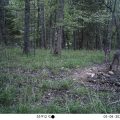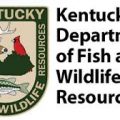Mineral Licks
I was out refreshing my licks yesterday; it was too wet during turkey season to get the truck out into the pastures. The ones that were already well established had been hit hard. I started one new one, and I am going to see how that goes.
My opinions on licks have changed over the years. I started out by throwing out a block of salt in the Fall and wondering why I never saw deer. Over the years I figured out that:
1) Deer start hitting licks in early Spring. By August, they’re pretty well off them.
2) The peak of lick activity I’ve seen is June to mid-July.
3) Location is the key. You can’t just throw out salt and have a successful lick. Putting a lick near well-traveled corridors is the best. You can bend those trails a little to, say, bring the deer closer to a stand, but you won’t drag deer 1/4 mile out of their normal location to visit a place they’d never go to on their own.
4) There is such a thing as too many licks. It is like putting too many McDonald’s in an area– eventually the competition between locations hurts the profitability of all of them.
When I begin a lick, I start with pure mixing salt– no dicalcium phosphate or other additives. My feeling is deer don’t like the taste of dical. After they’re hooked on a site, then I’ll add the extra minerals. Every year, I try a few new places on the farm. Some work, some don’t. I have two sites that are perennial favorites for the deer.
So when is the best time to do a lick? For me, the best time to start is probably March. I then refresh the lick in May and add in minerals. To refresh an old lick I throw out the last bag in September. (Huh?) The deer aren’t going to hit the lick, but the salt will be there in the Spring when they get interested. This saves me worrying about it in February and March when everything is too soggy to get a truck back to the licks.
How do I do a lick? Don’t use blocks. Use rock salt, pellets, mixing salt– whatever. I dig a hole about a foot deep and about 1X3 or 2 X3. Then I throw in the salt, cover it back over and mix the salt and dirt together as I go. I save a handful of salt to put on top as a tease. Deer eat the dirt, and never get a chance to get much pure salt. Too much salt all at once is bad for them. This makes them work at it a bit, and it also gives them some trace minerals from the soil.
Here’s a good article on licks I use as a guide. It’s written by our local wildlife biologist:
Remember that licks are not magic. They got the bad reputation of being unethical from generations of hunters using them during the Spring and early Summer. By Fall, when most hunting seasons open, deer are not interested in salt licks. Yes, I have seen a few deer come and visit a lick over the years, but it is much less frequent than May and June.
Why use licks? For one thing, it habituates the deer to particular travel routes– especially doe. Deer are creatures of habit. You get them traveling in a certain way, and they will keep doing it throughout the year. Second, and this can be debated, is that deer do a lot of their own horticulture. If deer find something like paw paw, they’ll eat paw paw and then pass the seeds. That is true with a lot of what deer eat. What I find is that having a lick around gets deer hanging around. The next thing you know there’s more of what deer like to eat growing around the lick.
This post has already been read 746 times!
Views: 2





Comments
Mineral Licks — No Comments
HTML tags allowed in your comment: <a href="" title=""> <abbr title=""> <acronym title=""> <b> <blockquote cite=""> <cite> <code> <del datetime=""> <em> <i> <q cite=""> <s> <strike> <strong>